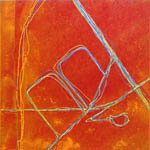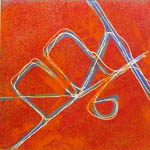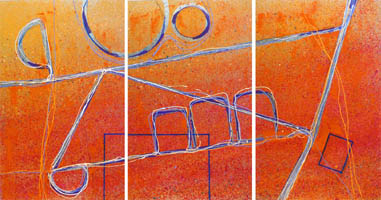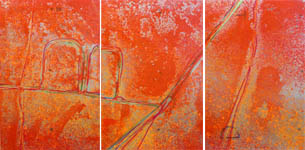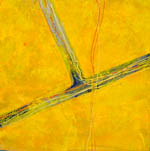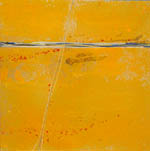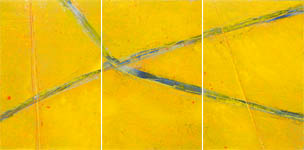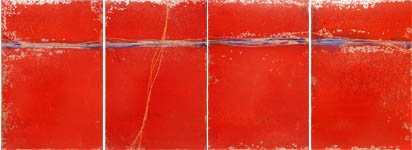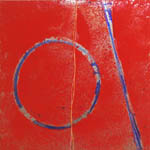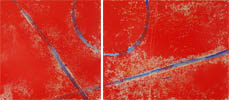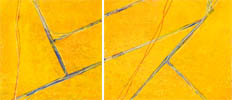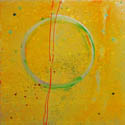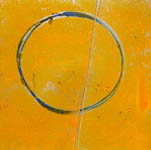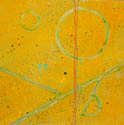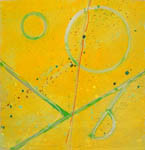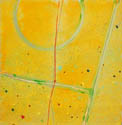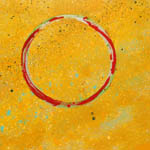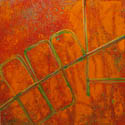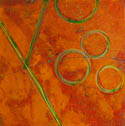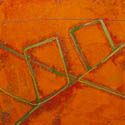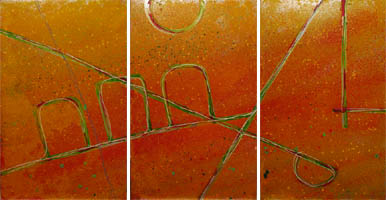|
Woomera
"My work is often compared to Indigenous art. In the past I have been careful to explain its origins in a very Western way, but this new work must acknowledge an indigenous presence if it is not to perpetuate further injustices. I have always felt it important to be sure that my work did not misappropriate items that should be the exclusive domain of indigenous culture, and while this is still the case I want to advance, with caution, to a time in which it will be possible to produce work that is described not as Western or Indigenous, but simply as Australian." These works are based on topographical images and symbols, showing the land as seen from an aerial view. They chronicle the scraping and digging, the etching into the land and the journeys across it that accompanied the building of the outback township of Woomera in the 1940s. Surrounded by vast and ancient emptiness, Woomera was originally intended to be a stronghold for rocket testing, built to propel Australia into the future; its secrets closely guarded and its workings often veiled… Click on any image to see a larger version WoomeraThe Woomera paintings of 2004-5 have their origin in trips that I made through that region in 1996 while working on the Andamooka series of paintings shown in 1997. Woomera is to me a mythic place. It sits at the edge of the outback, on the border between the yellow land of the coast and the red land of the centre. The town was borne of the Anglo-Australian Joint Project, laid out in 1948 as a base from which the threat of the Russia’s growing nuclear capabilities could be met. The government of Britain felt that a nuclear deterrent was needed, and the British rockets that would carry these nuclear warheads were to be tested here. I wanted to document this time, which seems in retrospect a simpler one than that in which we live today, but it should be remembered that it was also a time of great and real fear that nuclear calamity was imminent. The small community here is also akin to an Atlantis – there is evidence here of skills and powers that are now lost. Australia at that time could design and build its own aeroplane from scratch, and was able even to build a satellite. This time has passed, and the recent time when Woomera housed a detention centre has also has passed from this place that was built largely by post-war refugees. The next phase of its life may well be a nuclear dump, which seems a role that will have an impact on a geological time scale in a way that previous events have not. The journeys I seek to mark in this work belong to indigenous Australians as well as non-indigenous. Because similarities between my work and Indigenous work have been remarked, I have been particular in explaining, in a very Western way, the origins of what I have done. Perhaps because I grew up in the time of the Papunya Tula paintings of the 1980s and 1990s, I felt it important to be sure that my work did not misappropriate items that should be the exclusive domain of Indigenous culture. I think that now we should be able to advance, with caution, beyond that time. I see the desert areas of Australia as rich, vibrant and beautiful places, full of life and stories, and this is a view that is not now unusual. It is a view, also, that has developed along with our increasing awareness of the unique relationship that indigenous Australians have with their country. This is not the only source of this these feelings – the love of the land that in non-indigenous people who live there is genuine and should be celebrated – but to deny that this influence has come in part from our contact with Indigenous culture would be to perpetrate another injustice. So where to next? I think that the division of landscape painting into the rigid classifications of Western and Indigenous needs to be reconsidered. I hope that while painting in these established areas continues to flourish, there is also room at their edges for new work, in which ideas can be exchanged and new relationships can develop. These ideas led to a talk given at the 2004 Adelaide Festival Fringe – Directions
in Australian Landscape Painting; Towards the Post-Western?, the edited
text of which may be downloaded as PDF from the link above.
|
